Cost Assessment Tool
Economic Analysis of the National Breast and Cervical Cancer Early Detection Program (NBCCEDP)
Attachment 4. NBCCEDP CAT and UsersManual_2010
Cost Assessment Tool for the National Breast and Cervical Cancer Early Detection Program (NCBBEDP)
OMB: 0920-0776
Attachment 4
NBCCEDP Cost Assessment Tool User’s Manual
Form Approved OMB
No. 0920-0776
Exp. Date: 03/31/2011

Cost Assessment Tool
User’s Manual
Public reporting burden of this collection of information is estimated to average 22 hours per program, including the time for reviewing instructions, searching existing data sources, gathering and maintaining the data needed, and completing and reviewing the collection of information. An agency may not conduct or sponsor, and a person is not required to respond to a collection of information unless it displays a currently valid OMB control number. Send comments regarding this burden estimate or any other aspect of this collection of information, including suggestions for reducing this burden to CDC/ATSDR Reports Clearance Officer, 1600 Clifton Road NE, MS D-74, Atlanta, GA 30333, ATTN: PRA (0920-xxxx). Do not send the completed form to this address.
![]()

TABLE OF CONTENTS
INTRODUCTION 1
1. GRANTEE DETAILS 5
2. TOTAL EXPENDITURE 9
3. IN-KIND CONTRIBUTION 12
4. PERSONNEL EXPENDITURE 14
5. CONSULTANT EXPENDITURE 16
6. SCREENING EXPENDITURE 17
7. EXPENDITURES FOR NON-SCREENING ACTIVITIES PERFORMED BY HEALTH DEPARTMENTS/CENTERS OR PROVIDERS 21
8. EXPENDITURES ASSOCIATED WITH CONTRACTS, MATERIALS, TRAVEL, AND SERVICES 22
9. ADMINISTRATIVE EXPENDITURES 23
10. RESOURCE ALLOCATION TO BREAST VERSUS CERVICAL CANCER SCREENING FOR SELECTED ACTIVITIES 25
11. SCREENING AND DIAGNOSTIC ACTIVITIES SUPPORTED THROUGH THE USE OF NON-FEDERAL FUNDS 26
12. CONFIRMATION OF COST DATA 27
APPENDIX A: LIST OF NBCCEDP GRANTEES 28
APPENDIX B: NBCCEDP PROGRAM COMPONENTS/ACTIVITIES 30
INTRODUCTION
This manual was written to assist the NBCCEDP grantees to provide the information requested in the Cost Assessment Tool (CAT). The CAT is used to collect information on cost data elements. This data collection effort will provide CDC with activity-based cost elements to understand the cost of the various activities performed by the NBCCEDP grantees, the factors that may impact these costs, and the cost-effectiveness of the programs. Based on these analyses, CDC can utilize a systematic process to allocate program funds based on grantees’ past performance and future needs. The cost data collected will also be used by the grantees themselves to improve efficiencies within their programs.
The information collected in the CAT consists of a set of standardized cost data elements developed to ensure that consistent and complete information on annual expenditures, in-kind contribution, staff and consultant salaries, screening costs, contracts and material costs, provider payments, administrative costs, and allocation of funds and staff time to breast cancer versus cervical cancer screenings are collected on all NBCCEDP grantees. Because the objective of the cost data collection is to collect activity-based cost data, information on costs incurred should be reported rather than budget data. For example, budget data is the amount anticipated to be spent on screening services (e.g., as calculated in the Clinical Cost Worksheet), whereas the CAT will collect the actual amount spent on screening based on the amount reimbursed to providers.
The data is collected via the web (http://nbccedp.rti.org) to reduce respondent burden, data collection errors and delays in receiving data. The web-based tool includes several features to specifically reduce burden and collect high quality data. For example, the tool contains automated data checks so that the grantees can perform self-directed quality checks on the data as they enter it. In addition, the list of NBCCEDP activities is provided in drop-down boxes to eliminate the time spent typing in text. The tool also contains an interactive user’s guide that provides variable definitions and instructions for providing the required data elements.
Contact Information : Please contact Sujha Subramanian from RTI International if you have any questions regarding the questionnaire.
Sujha Subramanian, Ph.D.
411 Waverley Oaks Road, Suite 330
Waltham, Massachusetts 02452-8414
Phone: 781-434-1749
Email: [email protected]
Specific goals of the NBCCEDP CAT User’s Manual are to:
Provide technical information necessary to complete the cost data questionnaire.
Provide conventions to use in preparing the data.
Provide guidelines for ensuring data quality.
Provide examples of the data entry forms.
Provide technical assistance to the grantees.
Data coordinators for each grantee will use the NBCCEDP CAT User’s Manual as they collect and prepare the data for submission to RTI. Please select the fiscal year for program costs on the Home page using the drop-down box.
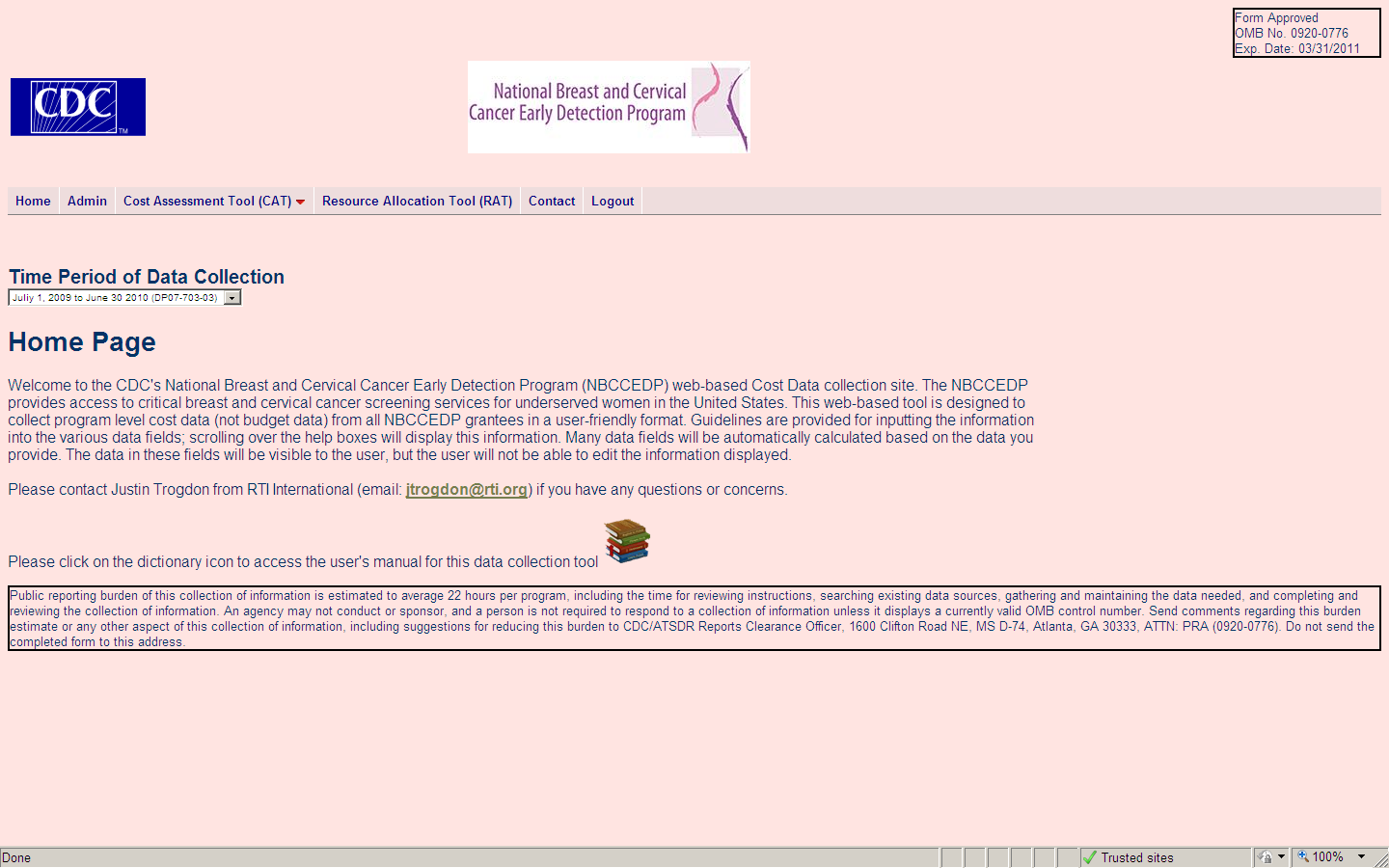
Navigation of the CAT Screens
The CAT can be completed over several sessions by saving work in progress. Once the information for each screen is completed, grantees should save the information. ‘Save and Exit’ will save the information for the page and take the user back to the Home Page. ‘Save and Continue to Next Section’ will save the information and take the user to the next screen.
On Screens 2 through 6 and 8 grantees must click ‘Add Item’ before the information in the cells directly above the ‘Add Item’ button is stored. Selecting ‘Save and Continue to the Next Section’ or ‘Save and Exit’ will NOT save the information in the cells without first selecting ‘Add Item’.
Users can also skip to screens within CAT by scrolling over the CAT menu and selecting the desired screen. Information entered on a screen will not be saved unless one of the Save buttons is clicked.
After completing the 11 screens, grantees will confirm that their cost data is ready for use by CDC on screen 12.
To begin, move the mouse over the CAT menu and select ‘1. Grantee Details’
1. GRANTEE DETAILS
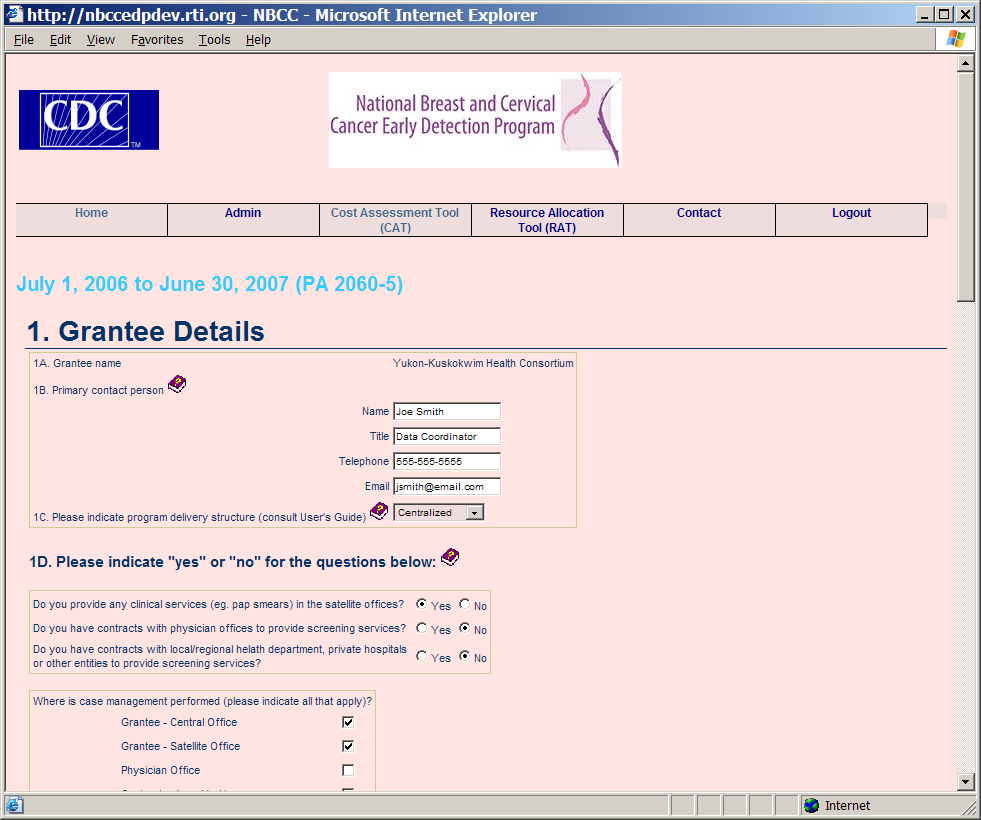
1B. Please enter the primary staff contact information. This person will be contacted if there are any questions regarding the data elements provided.
1C. Please enter the type of service delivery system. Please refer to the definitions of the service delivery system below before making the selection.
i. Centralized program structure: grantee provides clinical services in its satellite, or geographically separate, offices (may exclude mammograms and diagnostics), pays the salary of clinicians who provide services in various locations by arrangement, provides all case management (CM) services, performs all data entry and analysis, performs all billing and reimbursement services, and performs all public education and outreach activities.
ii. Mixed program structure: grantee contracts directly with physician offices for all clinical services, contracts directly with physician offices to provide all CM services. Contractor(s) enter data in database, and grantee runs reports/conducts analysis. Hired contractor performs all billing and reimbursement services. Grantee assesses public education and outreach needs, develops messages and sets priorities, and contractors deliver public education and outreach.
iii. De-centralized program structure: grantee contracts with local/regional health departments, private hospitals or other entities to fully manage and subcontract screening and diagnostic services, to provide and/or subcontract CM services, and perform billing and reimbursement services. Contractors collect, enter and analyze data, assess public education and outreach needs, set priorities and provide public education and outreach.
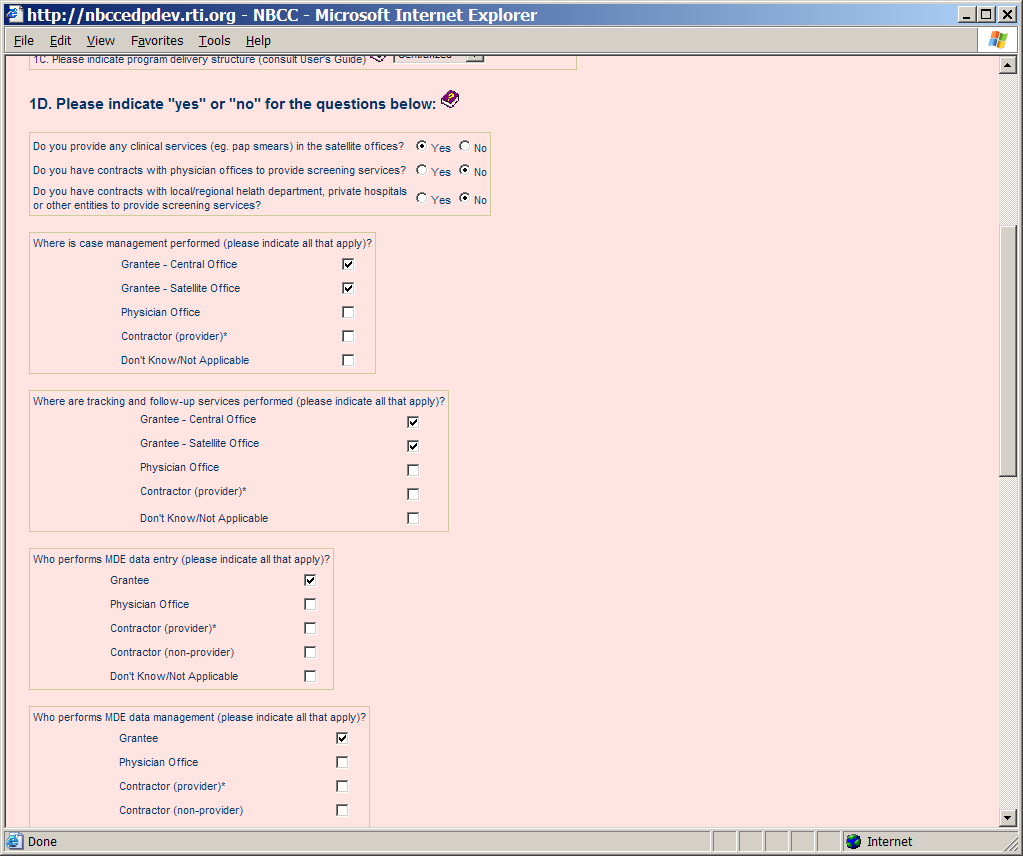
1D. Please indicate ‘yes’ or ‘no’ for each question in the first box. For the remaining questions, please check all categories that apply. The responses to these questions will be reviewed to ensure that the program delivery structure is specified consistently across all grantees.
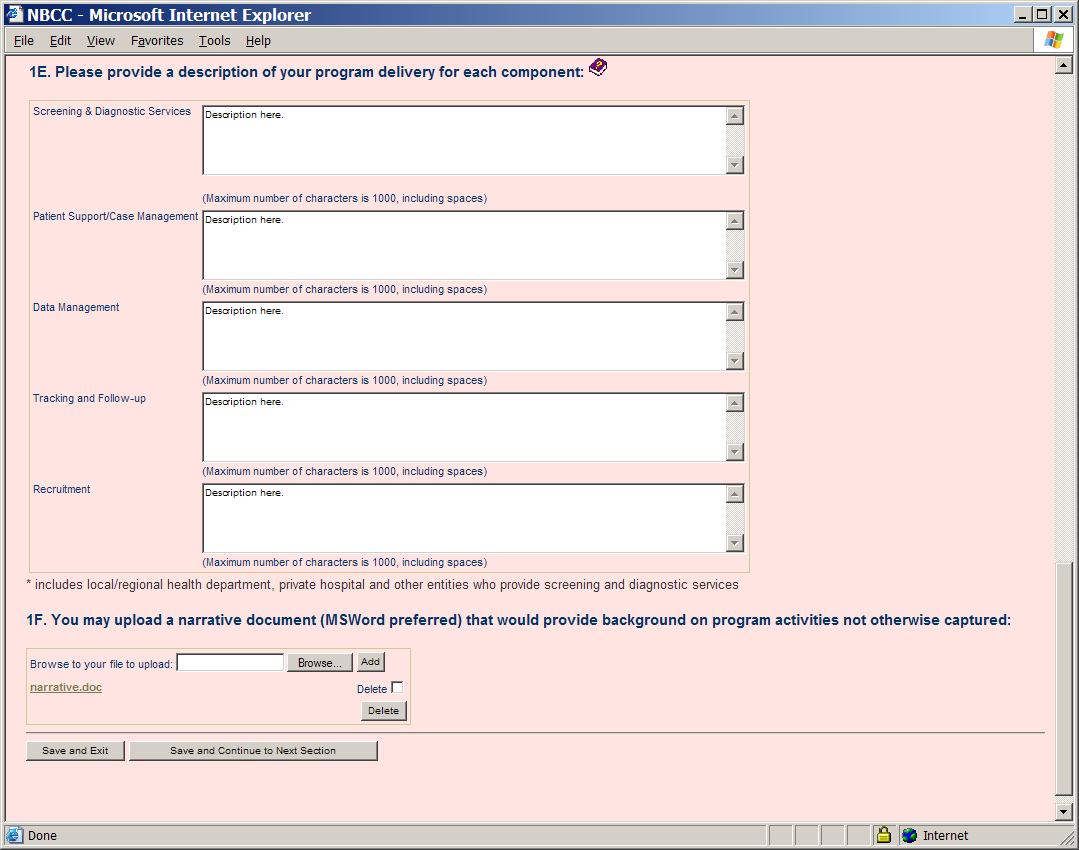
1E. Please provide a description of your program delivery for screening and diagnostic services, patient support/case management, data management, tracking and follow-up, and recruitment in less than 200 words (1000 characters) for each. Description of these activities is provided in Appendix B of the User’s Manual.
1F. (Optional) Programs can upload a narrative document in which they provide additional information about their CAT data, program operations/practices, or general comments about their program. Please limit the narrative to information not reported elsewhere in the CAT. Click ‘Browse’ to locate the file on your computer and ‘Add’ to upload the selected file. Files should be in either Microsoft Word or PDF format.
2. TOTAL EXPENDITURE
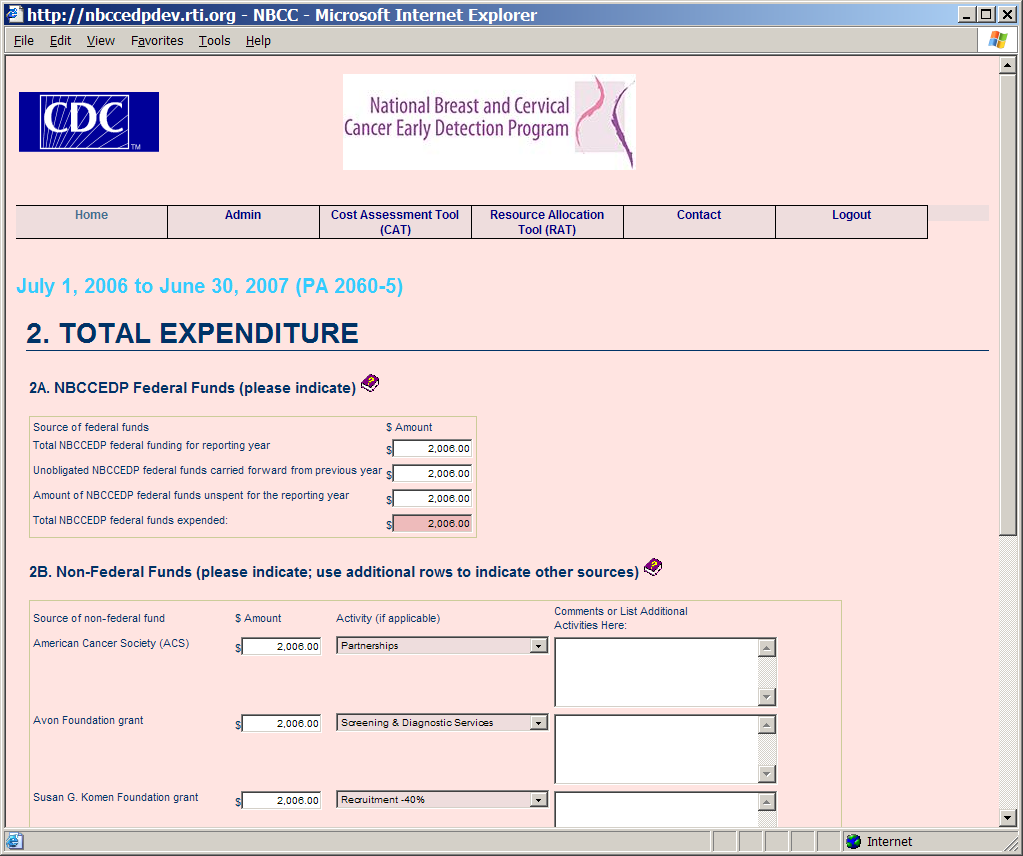
2A. NBCCEDP Federal Funds: Enter dollar amounts for total NBCCEDP federal funding for reporting year, unobligated NBCCEDP federal funds carried forward from previous year, and amount of NBCCEDP federal funds unspent for the reporting year. ‘Total NBCCEDP federal funds expended’ will be automatically calculated using this formula:
Total NBCCEDP federal funds expended = (total NBCCEDP federal funding for reporting year + unobligated NBCCEDP federal funds carried forward from previous year) – (amount of NBCCEDP federal funds unspent for the reporting year)
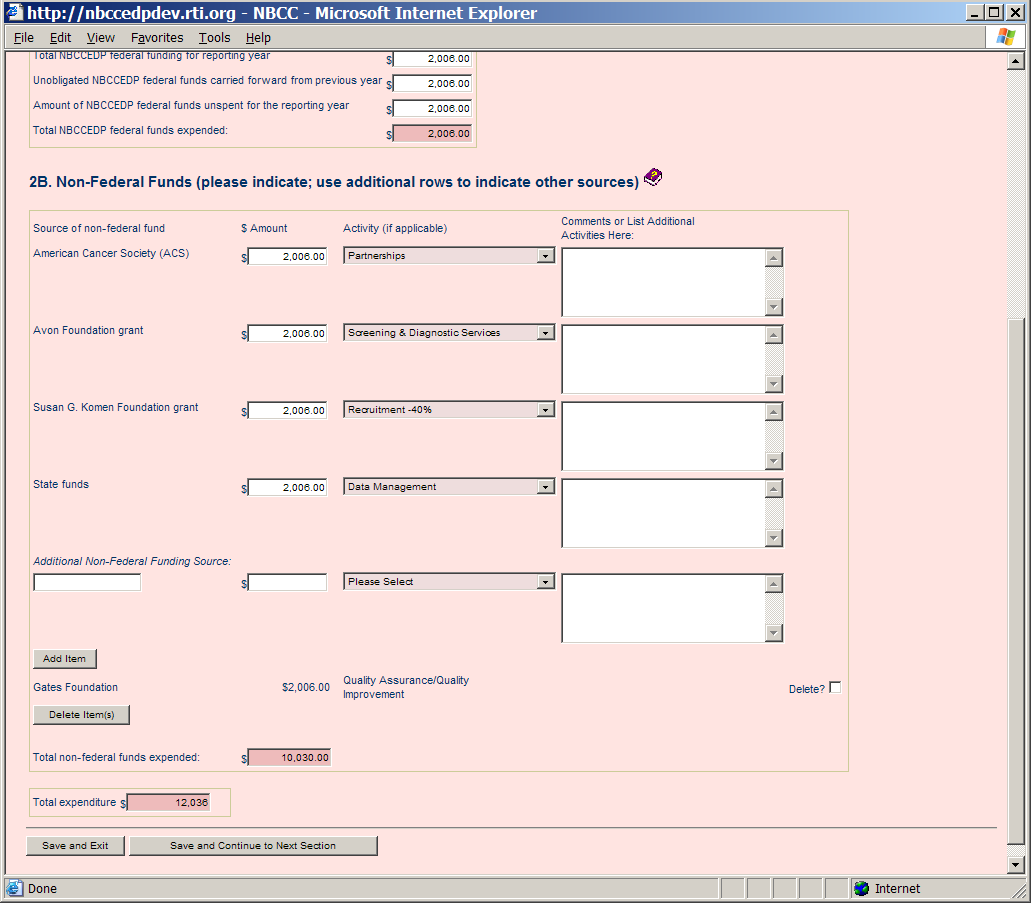
2B. Non-Federal Funds: For each of the four sources of non-federal funds listed, please list the amount of the funds for the reporting year and select an activity these funds support (if applicable). If you have not received funds from any of the four sources listed, please enter the amount as zero. For ‘activity’ funded by source, select from the choices in the drop down boxes. These activities are explained in detail in Appendix B. If you wish to include additional sources of non-federal funding, you can type in the requested information and add items one at a time by selecting ‘Add Item.’ (NOTE: Here and throughout the CAT, selecting ‘Save and Continue to Next Section’ or ‘Save and Exit’ will NOT save information without first selecting ‘Add Item’.) Total non-federal funds will be automatically summed. The total expenditure row is also automatically calculated using the formula:
Total expenditure = total NBCCEDP federal funds expended + total non-federal funds expended
CHECK POST 1: PLEASE MAKE SURE THAT YOU ENTER COST DATA (AMOUNT SPENT IN FISCAL YEAR).
3. IN-KIND CONTRIBUTION
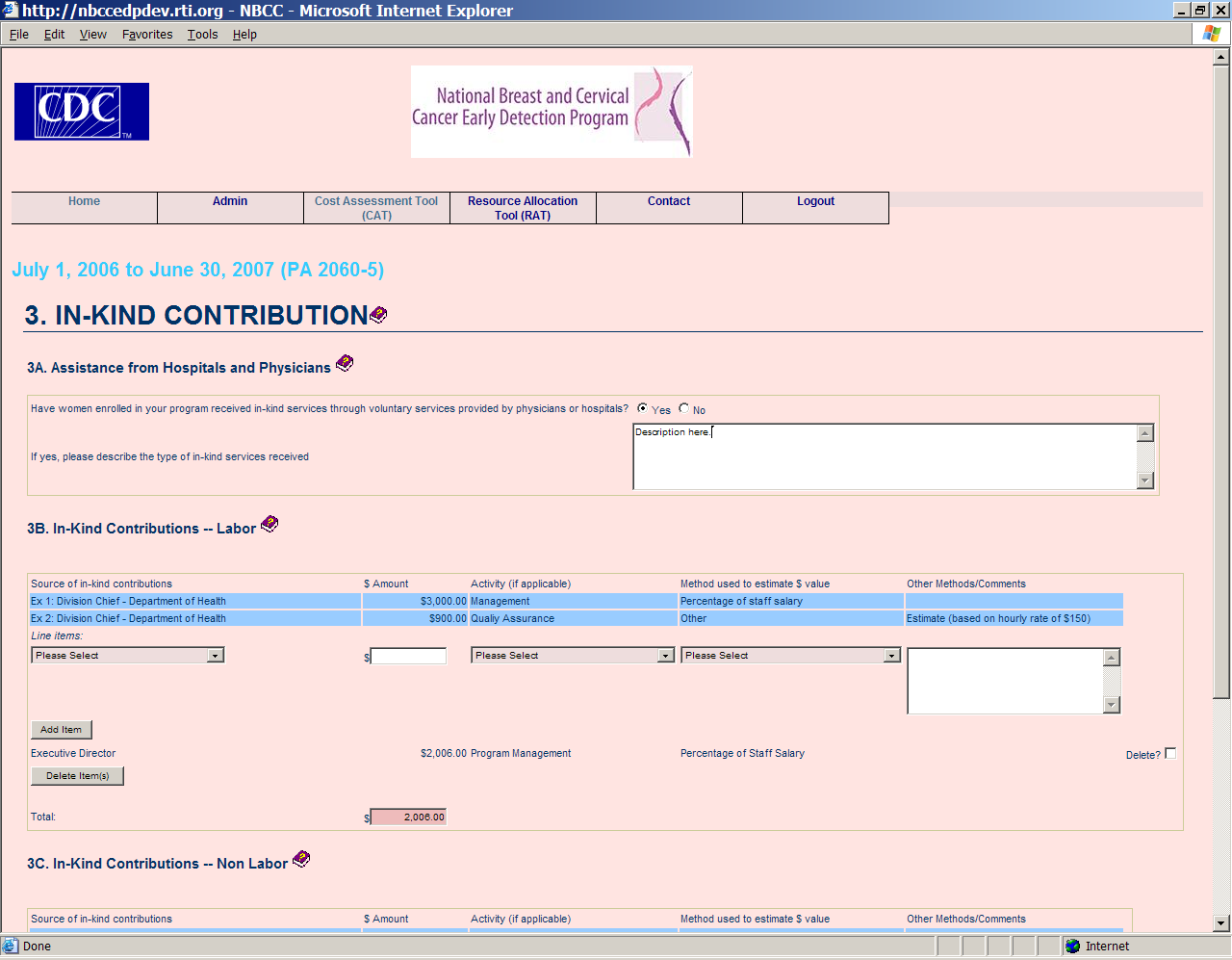
3A. Please indicate if your program receives any in-kind contribution from voluntary activities performed by physicians or hospitals.
3B. In-Kind Contributions—Labor: Please choose the ‘source of in-kind contributions’, ‘activity funded by source’, and ‘method used to estimate $ value’ from the drop down boxes. If one funding source provided monies for more than one activity then they can be listed on multiple rows with the dollar amount relevant to specific activities. If you wish to include sources of in-kind contributions, you can type in the requested information and add items one at a time. The choices for ‘method(s) used to estimate $ value’ are: Market price, Differential between charges and market price, Differential between charges and Medicare rates, Percentage of staff salary, and Other. An additional column is provided if you use other method(s) for calculating $ value or if you have any comments. The totals will be calculated automatically. The choices for program activities remain the same as above (please see Appendix B of the User’s Manual).
3C. Please follow the same instructions as in 3B. The drop down categories for the source of in-kind contribution are non-labor in this case. The total in-kind contribution is calculated as follows:
Total in-kind contribution = total in-kind labor contributions + total in-kind non-labor contributions
Check Post 2: Only enter in-kind contributions that were provided or incurred during the fiscal year.
4. PERSONNEL EXPENDITURE
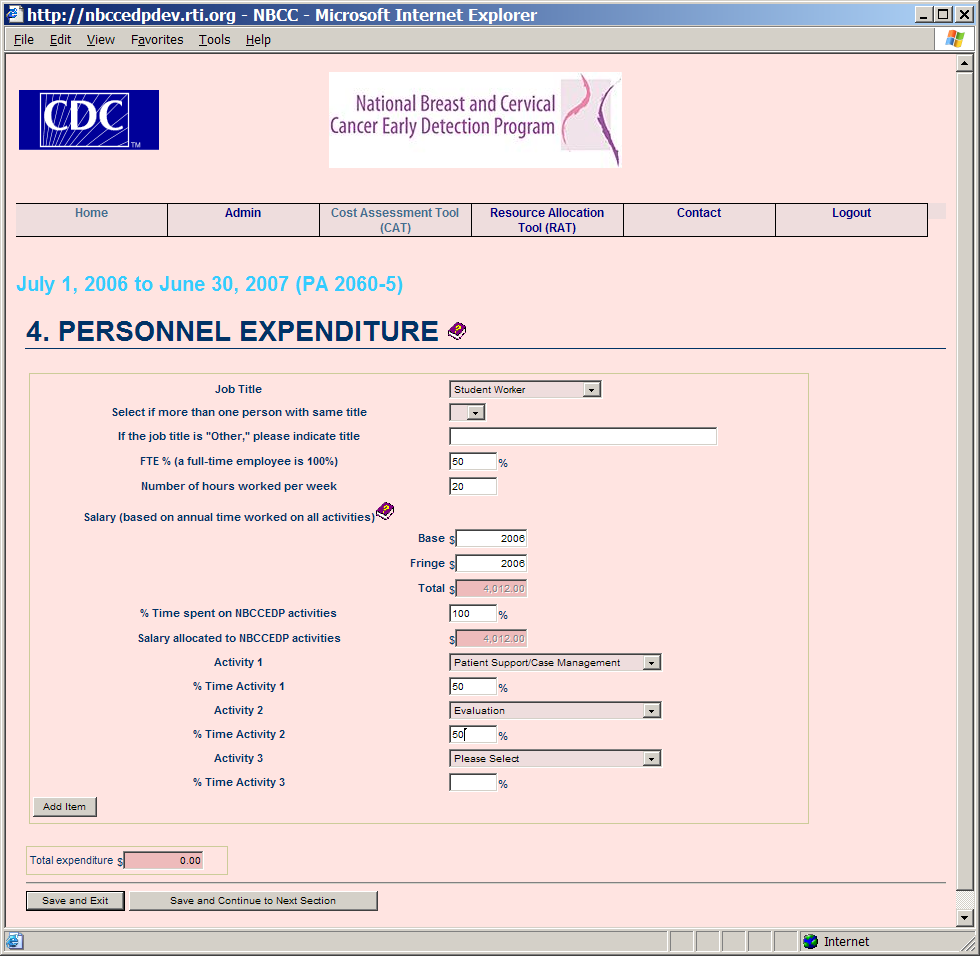
Please provide information for each employee in your program. Please enter the appropriate job title for the staff member from the list provided in the drop down box. Under “FTE %” (Full-Time Equivalent) provide the total proportion of time employed. For example, 100% would indicate a full-time employee and any other percentage less than 100% would indicate a part-time employee. In the spaces provided for salary information, please enter the base and fringe salary amounts and the total will be calculated automatically. Under ‘% time spent on NBCCEDP activities’ indicate the proportion of time spent specifically on NBCCEDP related tasks. For example, a program director may spend 10% time on NBCCEDP activities and 90% time supervising other programs. Please indicate up to three main activities performed within the NBCCEDP by the staff member and the percent of total time spent on each. If an individual performs less than three activities, please leave unneeded boxes blank. The percent time spent on all three activities should equal 100%. The choices for program activities remain the same as above (please see Appendix B of the User’s Manual).
Check Post 3: Please make sure salaries entered in the questionnaire are the full annual salaries earned by staff members and not only the amounts related to NBCCEDP activities.
5. CONSULTANT EXPENDITURE
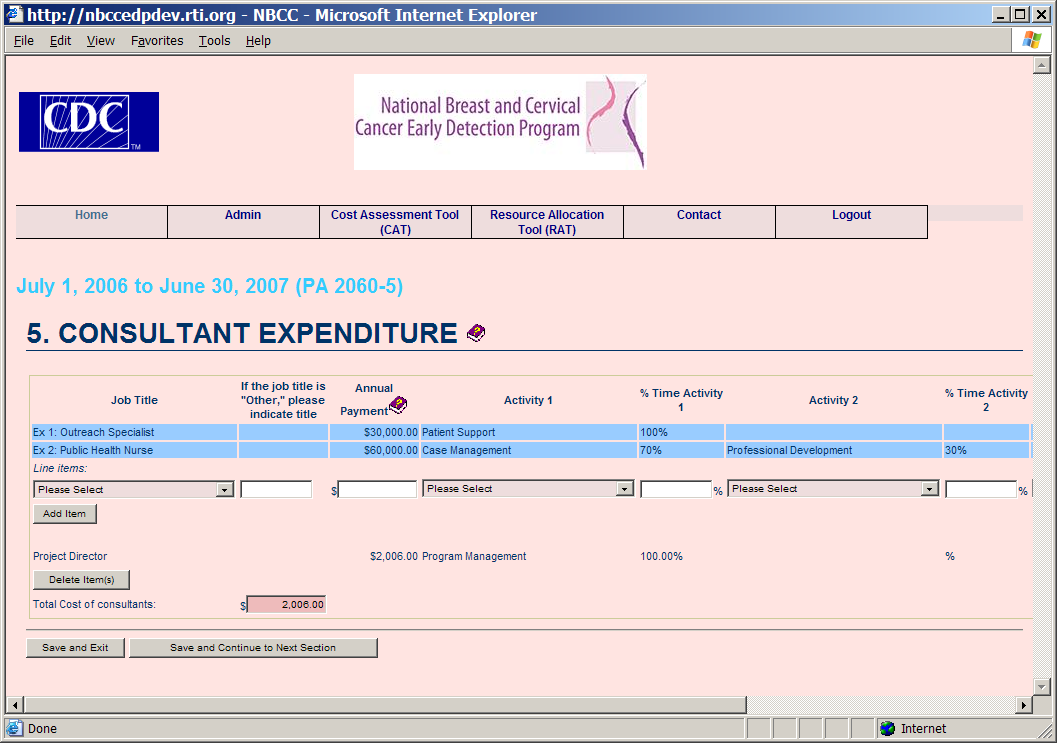
Please enter the appropriate job title for the consultant from the list provided in the drop down box. Similar to personnel expenditure, in the activities columns, please indicate up to three main activities performed for each consultant and the percent of total time spent on each. If an individual performs less than three activities, please leave unneeded boxes blank. The percent time spent on all three activities should equal 100%. The choices for program activities remain the same as above (please see Appendix B of the User’s Manual).
Check Post 4: Only payments made for services incurred during the fiscal year should be reported.
6. SCREENING EXPENDITURE
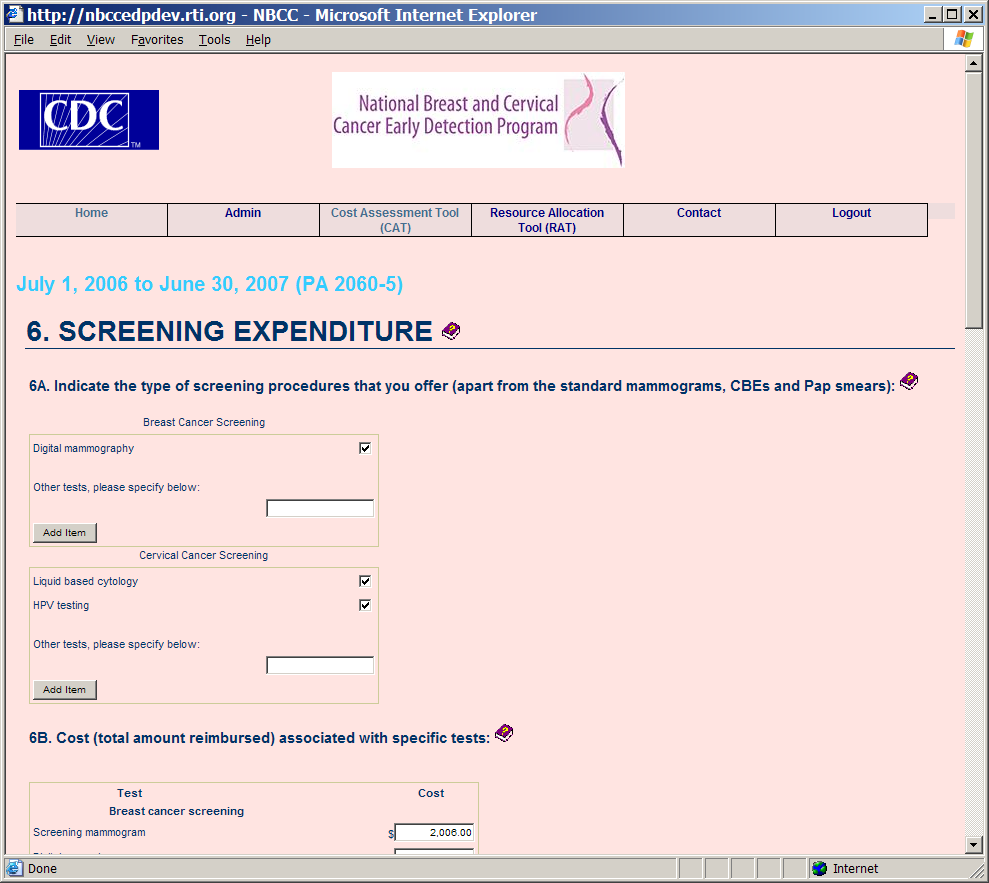
Please provide details on the cost associated with screening and follow-up diagnostic tests.
6A. Please indicate whether or not your program offers the screening procedures listed by checking the box to the right of the listed procedure. If your program offers screening procedures other than those listed, you can type in the requested information and add items one at a time.
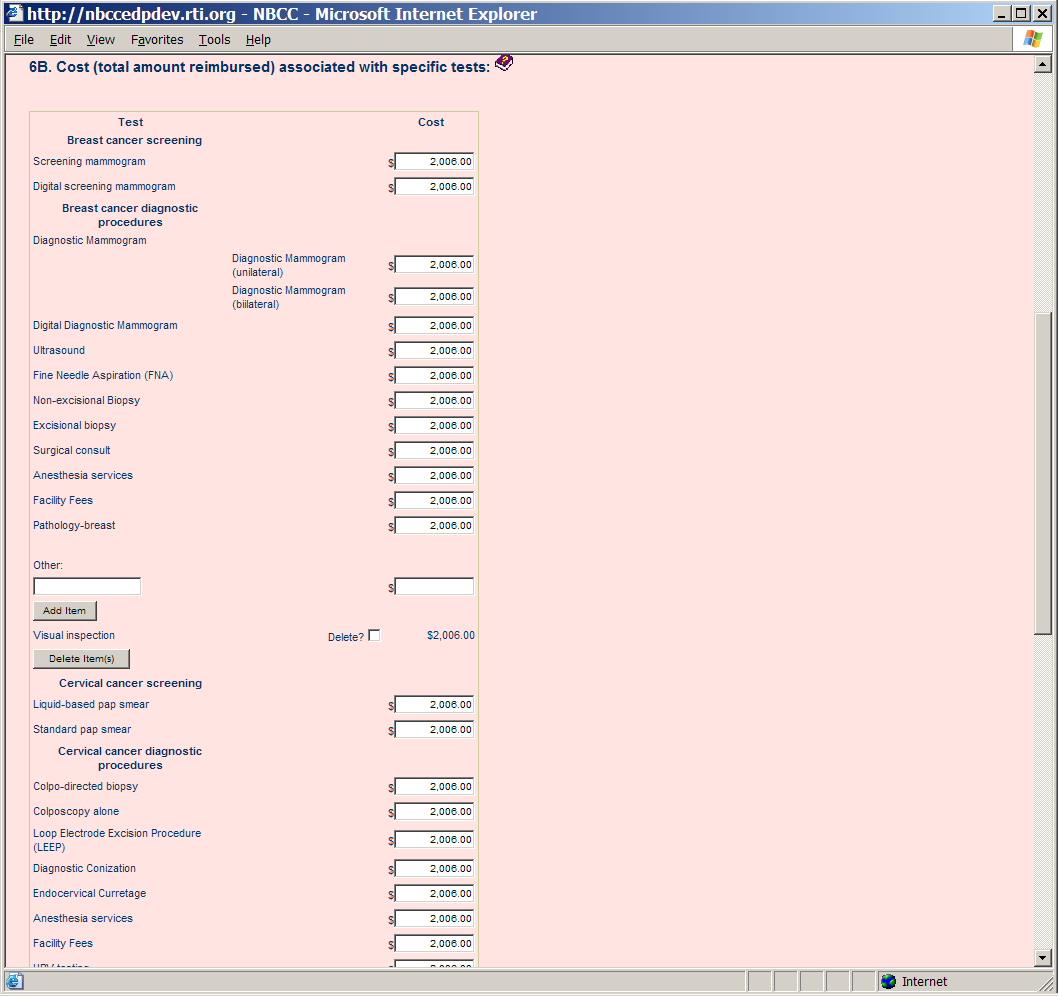
6B. Please enter costs (total amount reimbursed) associated with the specific tests without the cost of office visits. If your program offers diagnostic procedures other than those listed, enter the type of procedure and the costs and add items one at a time.
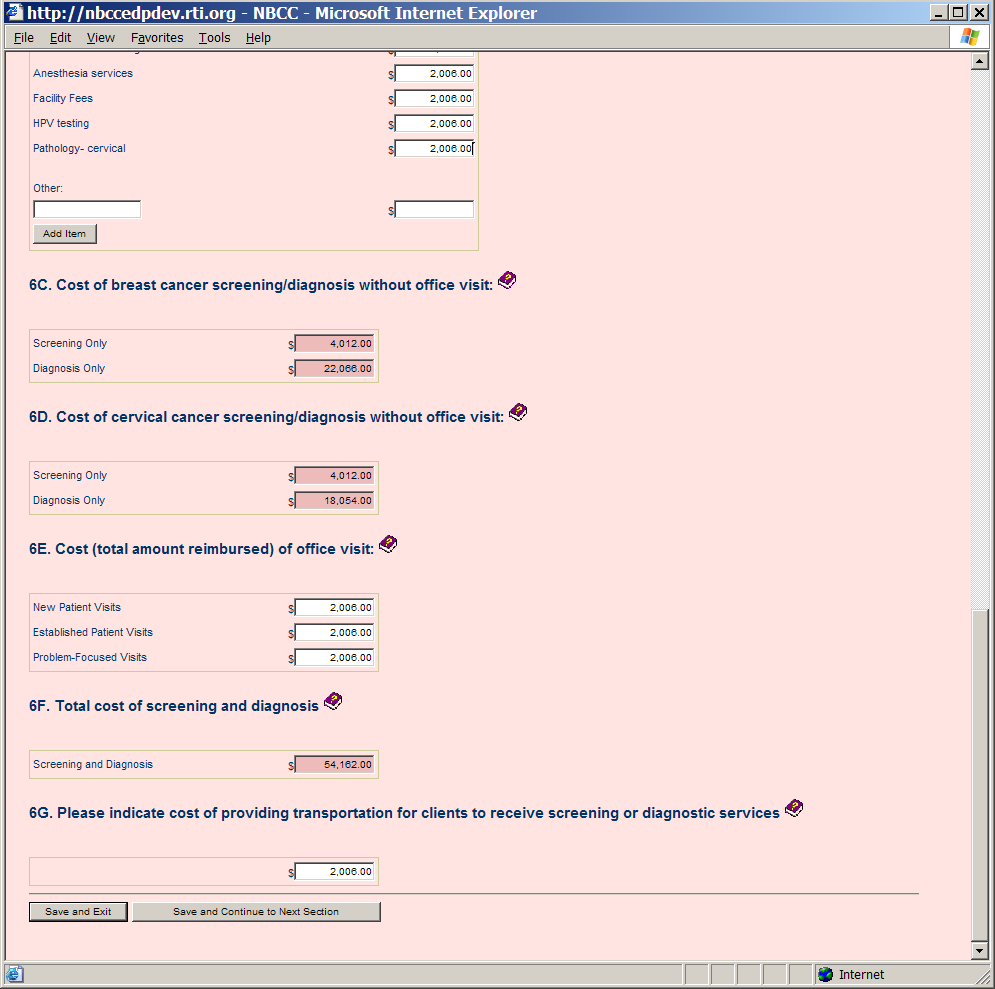
6C. The costs of breast cancer screening and diagnostic tests without the cost of office visits will be automatically calculated in section 6C from the information entered in section 6B.
6D. The costs of cervical cancer screening and diagnostic tests without the cost of office visits will be automatically calculated in section 6D from the information entered in section 6B.
6E. Please specify the cost for office visits. New Patient Visits are visits in which the patient has not been seen by the provider before, so the visit will be longer and more expensive. Established Patient Visits are visits in which the patient has been seen by the provider before, so visit can be shorter and less expensive. Problem Focused Visits are visits used to discuss abnormal results, make referrals, etc. and can vary in length and cost.
6F. The total cost of breast and cervical cancer screening will be automatically calculated in section 6F from the information in sections 6C, 6D, and 6E.
6G. Please provide the cost of transportation for patients receiving screening and diagnostic services only if your program reimburses for transportation costs.
7. EXPENDITURES FOR NON-SCREENING ACTIVITIES PERFORMED BY HEALTH DEPARTMENTS/CENTERS OR PROVIDERS
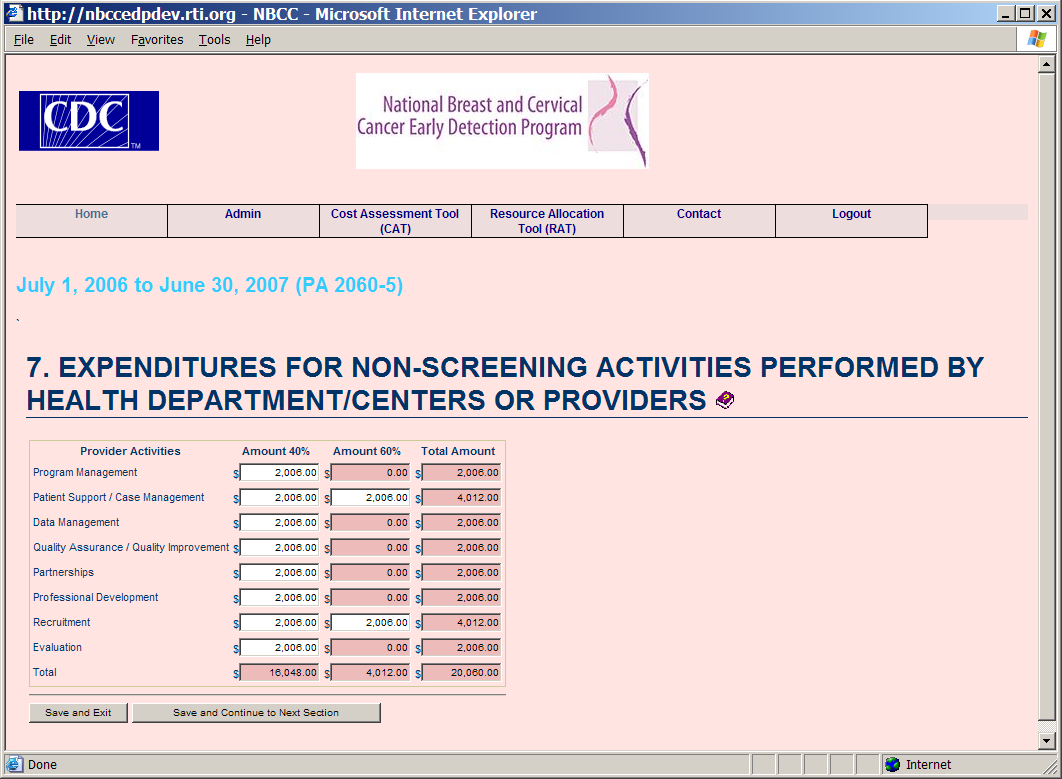
This section should only be completed by decentralized and mixed programs that provide funds to health departments or providers to perform activities other than screening and diagnostic services. These activities could include administration/site coordination, data collection and management, case management, recruitment, public education, and professional education. Please provide an estimate of the funds expended by the providers on the activities listed in this section. For each activity listed, please report expenditures that involved direct patient contact in the ‘Amount 60%’ column. Please report expenditures that did not involve direct patient contact in the ‘Amount 40%’ column.
8. EXPENDITURES ASSOCIATED WITH CONTRACTS, MATERIALS, TRAVEL, AND SERVICES
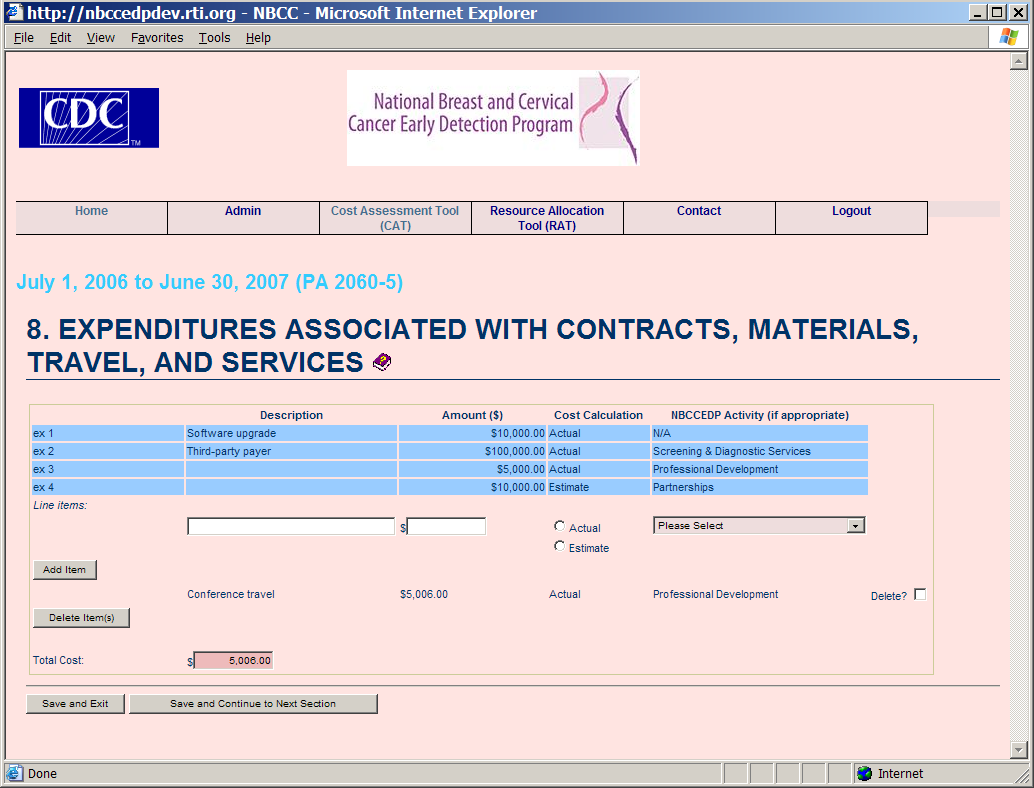
In this table, please use one row to report each contract or material purchased that was $5,000 or more. You can also include groups of related contracts or materials purchased if they totaled $5,000 or more (e.g., printing materials for multiple public health education campaigns that combined totaled more than $5,000 but not each individually). Report whether ‘actual’ or ‘estimated value’ is used to estimate the cost. If applicable, please indicate the single most appropriate program activity that the contracted service or material corresponds to. The choices for program activities remain the same as above (please see Appendix B of the User’s Manual).
9. ADMINISTRATIVE EXPENDITURES
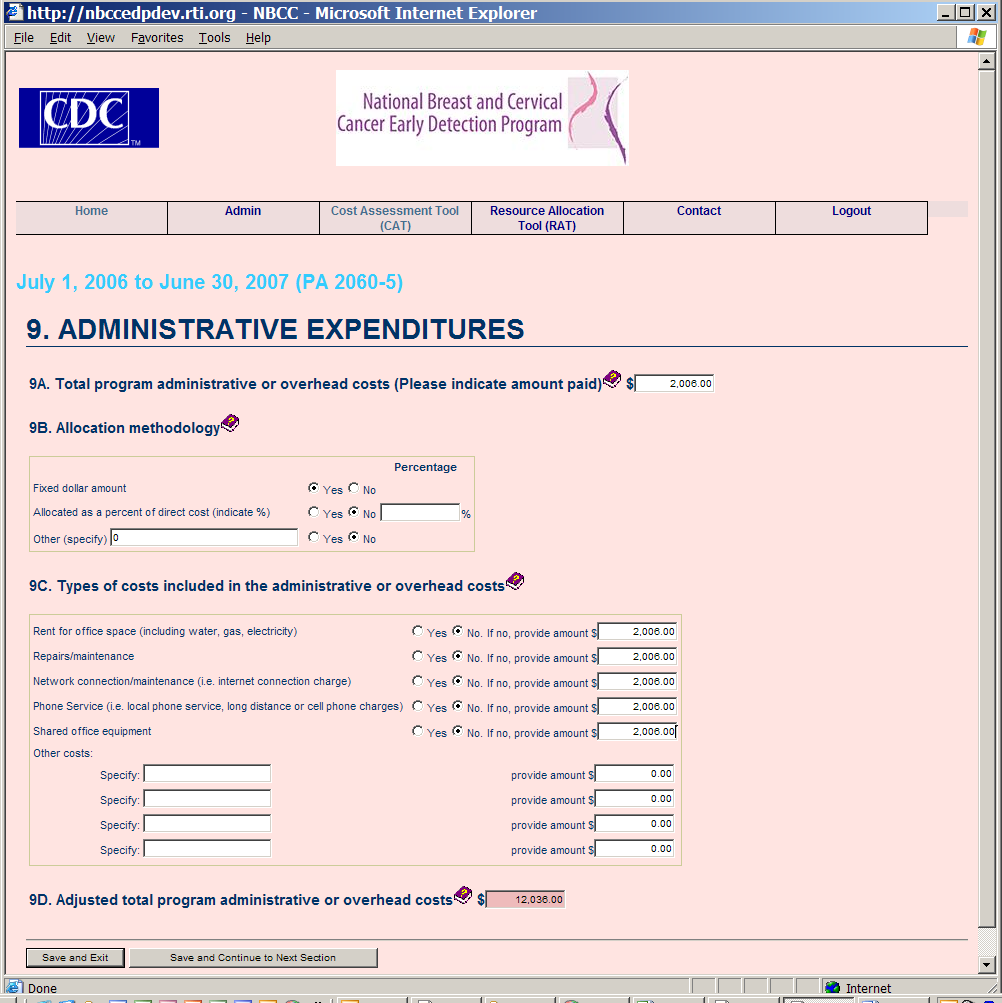
9A. Please indicate the amount paid for total program administrative or overhead costs.
9B. Please indicate the allocation method used for determining administrative costs. Examples of allocation methods include ‘fixed dollar amount’ and ‘allocation as a percent of direct costs.’ If administrative costs are allocated as a percent of direct costs, please indicate the percentage.
9C. Please indicate whether or not the costs associated with rent, repairs/maintenance, network connection/maintenance, phone service, and shared office equipment were included in overall administrative cost entered in section 9A. If these costs were not included in section 9A, please provide the amount expended on these items in section 9C.
9D. The adjusted total cost for program administration and overhead will be automatically calculated in section 9D from the information in sections 9A and 9C.
10. RESOURCE ALLOCATION TO BREAST VERSUS CERVICAL CANCER SCREENING FOR SELECTED ACTIVITIES
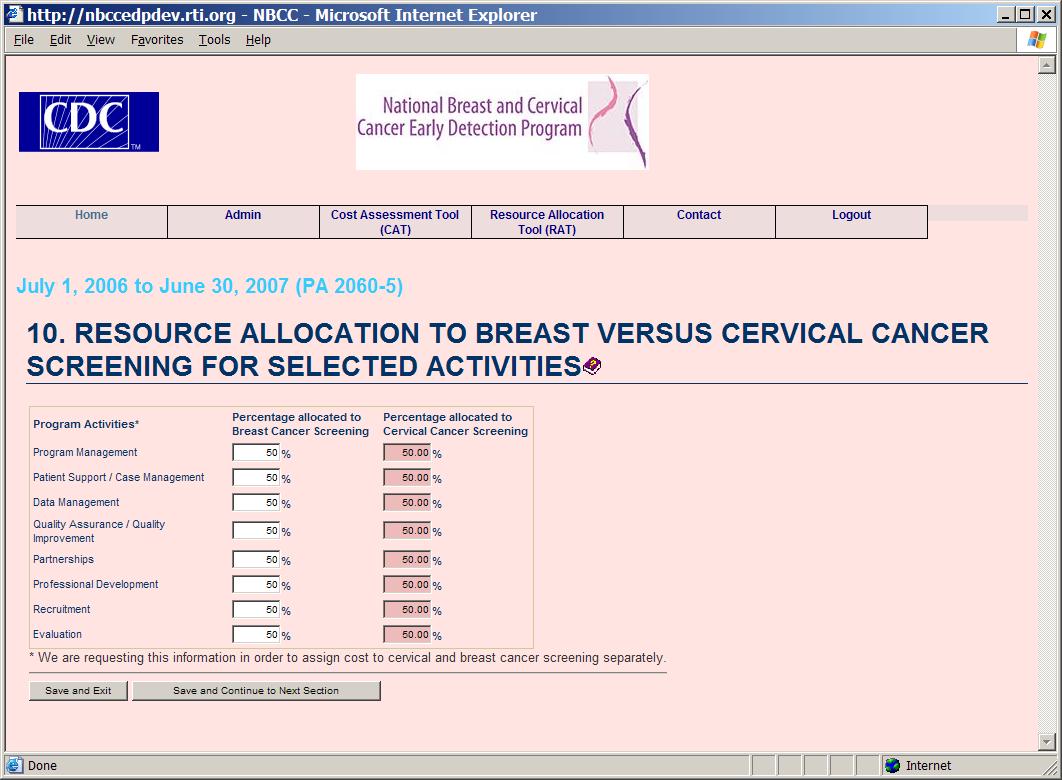
This information is requested to allocate cost of specific NBCCEDP activities appropriately to breast and cervical cancer screening. This information is required to assess the average cost of breast cancer screening and average cost of cervical cancer screening separately. Enter your best estimate of the proportion of resources allotted to breast cancer screenings and the proportion allotted to cervical cancer screenings will be automatically calculated using the formula given below.
Percentage of resources allotted to cervical cancer screening = 100- (Percentage of resources allotted to breast cancer screening)
11. SCREENING AND DIAGNOSTIC ACTIVITIES SUPPORTED THROUGH THE USE OF NON-FEDERAL FUNDS

If your program serves women through the use of non-federal funds - and these women are not reported through the Minimum Data Elements (MDE) submission - please provide the following data based on this group. Women and diagnoses reported here should be mutually exclusive of those reported through the MDEs.
Under 11A and 11B, “women screened” and “women served” are mutually exclusive from each other.
12. CONFIRMATION OF COST DATA
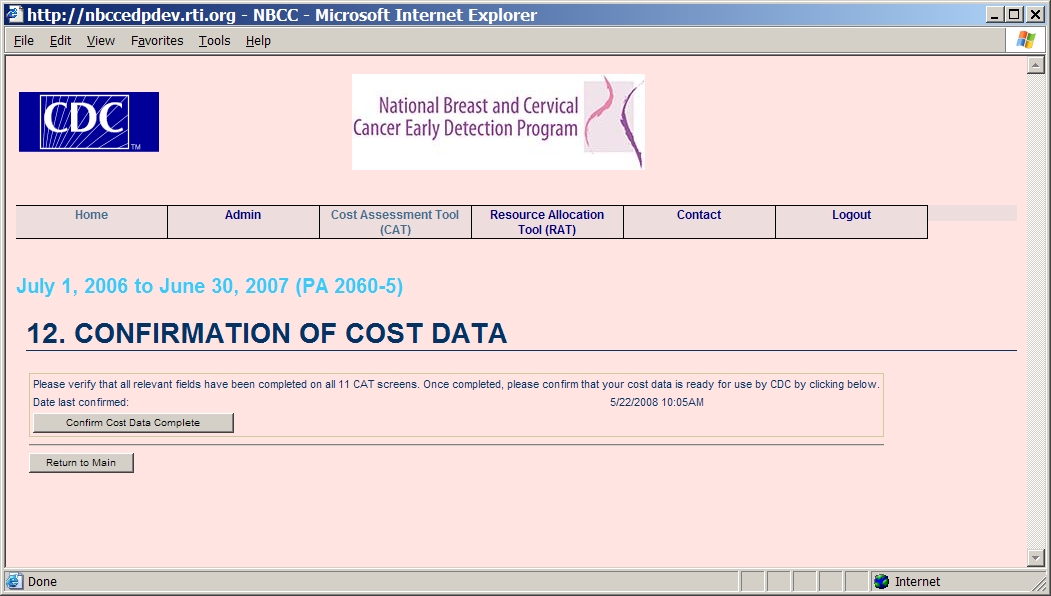
Please verify that all relevant fields have been completed on all 11 CAT screens. Once completed, please confirm that your cost data is ready for use by CDC by clicking ‘Confirm Cost Data Complete’.
Thanks for completing the web-based CAT.
APPENDIX A: LIST OF NBCCEDP GRANTEES
|
|
|
|
|
|
|
|
|
|
|
|
|
|
|
|
|
|
|
|
|
|
|
|
|
|
|
|
|
|
|
|
|
|
|
|
|
|
|
|
|
|
|
|
|
|
|
|
|
|
|
|
|
|
|
|
|
|
|
|
|
|
|
|
|
|
|
|
APPENDIX B: NBCCEDP PROGRAM COMPONENTS/ACTIVITIES
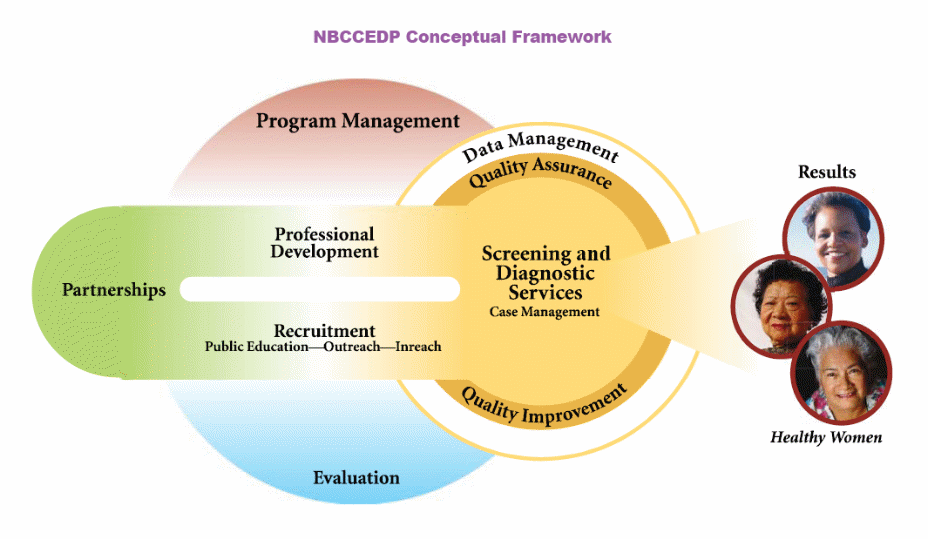
Program Management
Management and evaluation are represented by a sphere that symbolizes their all encompassing nature. The placement of management on top represents how all other parts of the program fall under this leadership. Managing these components requires a “systems approach” – understanding the bigger picture of how and why the program components interrelate to achieve optimal results.
Screening and Diagnostic Services
Screening and Diagnostic Services is represented as the core of the program. Providing these services to underserved women is the intent of the NBCCEDP. All other program components are related to and support the delivery of screening and diagnostic services to those most in need.
Patient Support/Case Management
Case Management represents a cooperative process between the client and her care provider intended to assure timely rescreening, diagnostic and treatment services. All NBCCEDP-enrolled women with an abnormal screening result must be assessed for their need of case management services and provided with such services accordingly.
Data Management
Data Management is represented as a circle surrounding Screening and Diagnostic (S&D) Services, indicating its focus on this component. Data, especially the results of the S&D services, should be used to inform and evaluate each of the other program components. All activities related to data collection and management should be reported in this category.
Quality Assurance/Quality Improvement
Quality Assurance/Quality Improvement is represented as an inner-circle to show its direct connection to S&D services. It works in concert with the data management and evaluation components to monitor, assess, and improve program outcomes. Quality Assurance is on the top representing the Program Management responsibility of assuring quality care. Quality Improvement is on the bottom showing its proximity to evaluation.
Partnerships
Partnership is represented as an extension to show that partnerships expand the reach, capacity, and resources of the NBCCEDP. Partnerships influence all components and partners play a key role in advancing the broader goals of the NBCCEDP - enhanced access and quality for all women.
Professional Development
Professional Development is one of two structural links that directly tie partnership to delivery of S&D services. Professional Development enhances service delivery.
Recruitment
Recruitment is one of two structural links that directly tie partners to delivery of S&D services. Recruitment creates demand from and provides a link to services for women most in need. Recruitment includes educating women about the importance of screening, explaining the services available, and removing their barriers.
Recruitment-60%
For recruitment to be considered a 60% (direct service) activity, it must be 'one-on-one' in nature. The activities must be directed toward an individual woman, such as an outreach worker approaching an age-appropriate woman at a supermarket and presenting her with information about the NBCCEDP.
Recruitment-40%
Any recruitment activity that is not ‘one-on-one’ in nature would be a 40% (program support) activity. For example, if the same outreach worker left a supply of NBCCEDP brochures at the supermarket, then this would be a 40% activity. Radio spots, making a presentation in front of a group, or participating in a health fair would all be 40% activities.
Evaluation
Management and evaluation are represented by a sphere that symbolizes their all encompassing nature. Evaluation is placed on the bottom to show it is the foundation of successful operation of all components individually and together.
| File Type | application/msword |
| Author | bbapat |
| Last Modified By | dce3 |
| File Modified | 2010-09-30 |
| File Created | 2010-09-28 |
© 2026 OMB.report | Privacy Policy